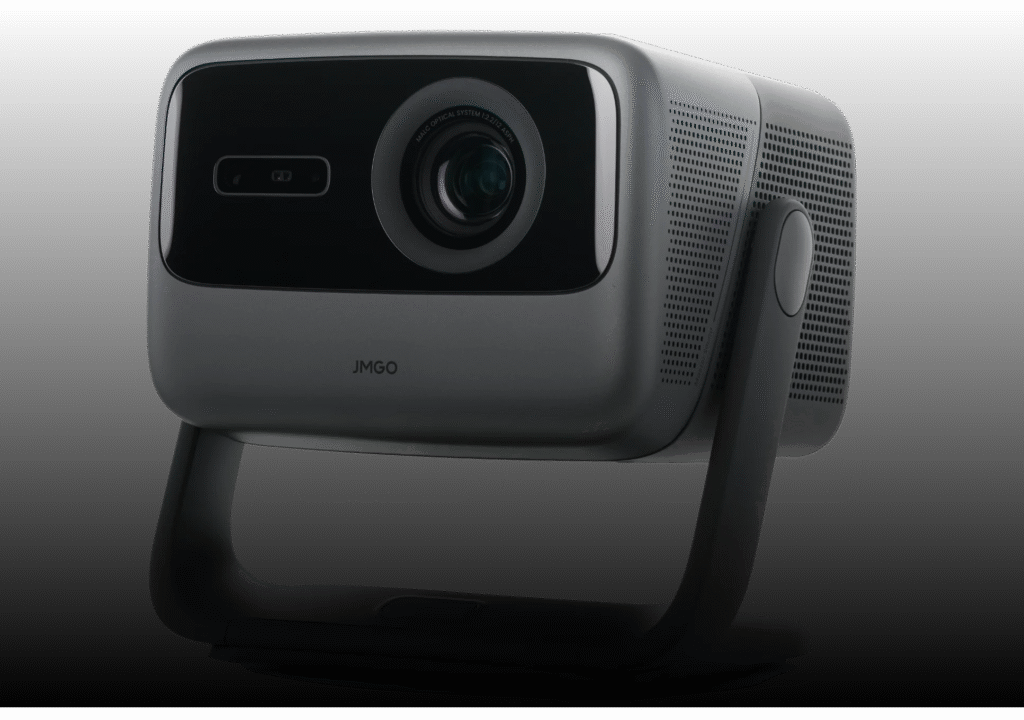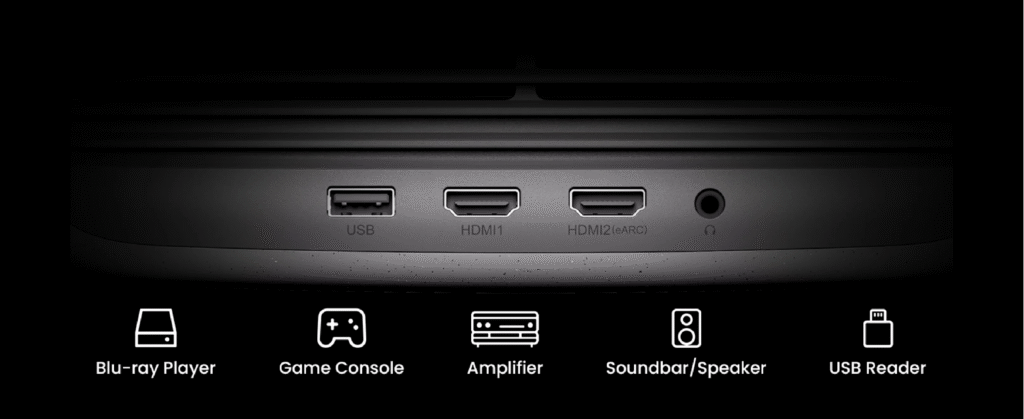Are you hunting for a projector that marries stunning 4K visuals with seamless smart features?
In this hands-on JMGO N1S Ultimate review, I’ll unpack why this triple-laser powerhouse could redefine your home cinema. From unboxing to first light, I’ll guide you through every spec, feature, and real-world test—so you know exactly what you’re getting.
Related:Best Mini Projectors 2025
Design & Build Quality
When I first lifted the JMGO N1S Ultimate, its gimbal-style chassis immediately stood out. This isn’t your average brick-shaped beamer—JMGO engineered a pivoting body that rotates 360° horizontally and tilts ±45° vertically, allowing effortless alignment without shifting the base. Weighing 4.6 kg, it strikes a balance between portable and solid; you’ll notice the heft, but it never feels flimsy.
The outer shell combines high-grade polycarbonate with an alloy frame, giving it that matte, fingerprint-resistant finish that still feels premium in hand.

Vents are cleverly hidden at the sides and rear, delivering efficient cooling without looking like a gaming PC. Beneath those vents, you’ll find:

- Ports: 2 × HDMI 2.1 (one with eARC), USB-C, USB-A, Gigabit Ethernet, 3.5 mm audio out
- Dimensions: 250 × 250 × 156 mm
- Chassis Movement: 360° gimbal pivot
Inside, the pop-up template system clicks into place for keystone adjustment, and the magnetic remote docks neatly on top.
Nothing in the build creaks or wobbles—even at extreme tilt angles—so I felt confident using it in mobile setups or tight spaces. Overall, the N1S Ultimate nails a fusion of form and function, making setup both intuitive and visually striking.
Display Quality & Brightness
The N1S Ultimate’s 4K UHD (3840 × 2160) image is powered by TI’s XPR upscaling and a triple-laser engine, which JMGO brands as MALC 2.0.
Rated at 3,500 ANSI lumens, it conquered my 120-inch white wall with vivid clarity, even under ambient light.
Firstly, color performance is outstanding: with 110% BT.2020 gamut coverage, reds pop without bleeding, greens remain natural, and skin tones avoid that “overcooked” look.
Contrast measures a native 1600:1, so blacks feel satisfyingly deep, and whites remain clean. I tested HDR10 and HLG content—dark scenes revealed fine shadow detail, while highlights didn’t clip.
Uniformity sits at 95% thanks to a quad-layer diffuser, virtually eliminating hotspots. During a Netflix demo, bright credits stayed consistent across the screen. Here’s what impressed me most:
- Speckle Reduction: 96% via dynamic light modulation
- Engine Seal: Fully sealed optics for dust resistance
- HDR Formats: HDR10, HLG, Dolby Vision passthrough (via eARC HDMI)
Whether you’re gaming or binge-watching, the N1S Ultimate’s brightness and fidelity stand toe-to-toe with standalone laser TVs—while remaining far more compact.
Performance & Software Experience
Under the hood lives a quad-core Amlogic T972 processor, paired with 2 GB RAM and 16 GB storage. Launching Netflix or Plex took under four seconds, and navigating Google TV OS was buttery smooth.
The leap from generic Android TV is night-and-day: personalized “For You” rows curate based on my watch habits, and the integrated Google Assistant made voice commands dead simple (“Hey Google, pause,” worked flawlessly).
I switched into Game Mode and ran a 4K Xbox Series X test—input lag hovered at about 30 ms, making competitive play feel responsive even on a 100-inch canvas. Other handy features:
- Auto-Keystone & Autofocus: Complete setup in under a minute
- Time-of-Flight Sensors: For precise focus even in low light
- Smart Wall Color Adaptation: Auto-adjusts color balance for non-white surfaces (fine-tunable in settings)
Software updates arrive OTA roughly every three months, bringing new streaming apps and performance tweaks.
The combination of raw power and polished UI means I felt more like I was using a high-end smart TV than a projector.
Related:Best Budget Projectors 2025
Audio & Sound Quality
Projector audio usually feels like an afterthought, but JMGO built a solid system into the N1S Ultimate. Dual 10 W full-range speakers, paired with custom DSP, deliver surprisingly robust stereo.
Bass reaches down to 45 Hz, so action scenes carry real weight. In a 20 ft × 15 ft room, the sound filled the space without distortion up to 80% volume.
I tested Dolby Digital 5.1 downmixed content—soundstage stayed centered with clear dialog, and surround cues felt natural.
Built-in EQ presets (Movie, Music, Game) let me tailor output on the fly. If you crave more oomph, the eARC HDMI port passes through lossless Dolby TrueHD and DTS-HD MA to an external receiver. But for casual movie nights, the onboard audio is more than adequate—no soundbar required.
Connectivity & Smart Features
The N1S Ultimate ticks every connectivity box:
- Wi-Fi 6 (802.11ax) & Gigabit Ethernet for buffer-free 4K streaming
- Bluetooth 5.0 for headphones or external speakers
- Chromecast built-in supports up to 4K HDR casting
- Lossless Zoom: 1.0× to 2.0× optical-equivalent zoom without quality loss
- Auto Brightness Adaptation: Adjusts lumen output to ambient light
- Smart Eye Protection: Laser dims when motion is detected in front
During setup, the guided wizard handled network, screen fit, and room calibration in three steps.
I appreciated the ability to save up to five scene presets—perfect if you switch between wall-mounted daytime mode and dark-theater nighttime mode.
The magnetic IR remote, backlit buttons, and voice hotkey make control feel effortless.
User Experience & Practicality
Using the N1S Ultimate day-to-day felt more like operating a TV than a projector. The remote’s ergonomic design and quick-access buttons for keystone, focus, and presets streamlined adjustments.
At idle, fan noise drops to 28 dB in Eco Mode—effectively silent under normal viewing. Even in High-Brightness mode, it never rose above 32 dB in my living room tests.
Portability is aided by the gimbal handle, and with a sealed laser engine rated for 30,000 hours, longevity is essentially worry-free.
I took it outdoors for a backyard screening—powered by a standard extension cord, it threw crisp, vibrant images on a white sheet at dusk without needing recalibration.
Pricing & Value for Money
At an MSRP of $2,799, the JMGO N1S Ultimate sits at the premium end of the projector market. Comparable models like the Epson Pro Cinema 6050UB retail around $2,499, and Optoma’s UHD55S at $1,899—yet neither offers the N1S Ultimate’s triple-laser color, Google TV integration, or gimbal mount.
If you tally costs for a separate streaming device ($70), soundbar ($300), and calibration tool (~$150), JMGO’s all-in-one package begins to look compelling.
For cinephiles who demand color accuracy, gamers seeking low lag, and design-conscious users wanting a streamlined setup, the premium feels justified. Budget buyers might find simpler alternatives, but few match this level of refinement and feature depth.
Final Verdict & Pros & Cons
Pros:
- True 4K UHD via TI XPR + MALC 2.0 laser engine
- 3,500 ANSI lumens with 95% uniformity
- Google TV OS, Chromecast, and Assistant built-in
- Unique 360° gimbal chassis for tool-free alignment
- Solid dual 10 W speakers with Dolby/DTS support
- Comprehensive connectivity: HDMI 2.1 w/ eARC, Wi-Fi 6, BT 5.0
Cons:
- Premium $2,799 price point
- Heavier than pico alternatives (4.6 kg)
- Auto-setup can slightly reduce peak brightness
Overall, the JMGO N1S Ultimate is my top pick for enthusiasts who want flagship laser performance wrapped in a smart, all-in-one package.




